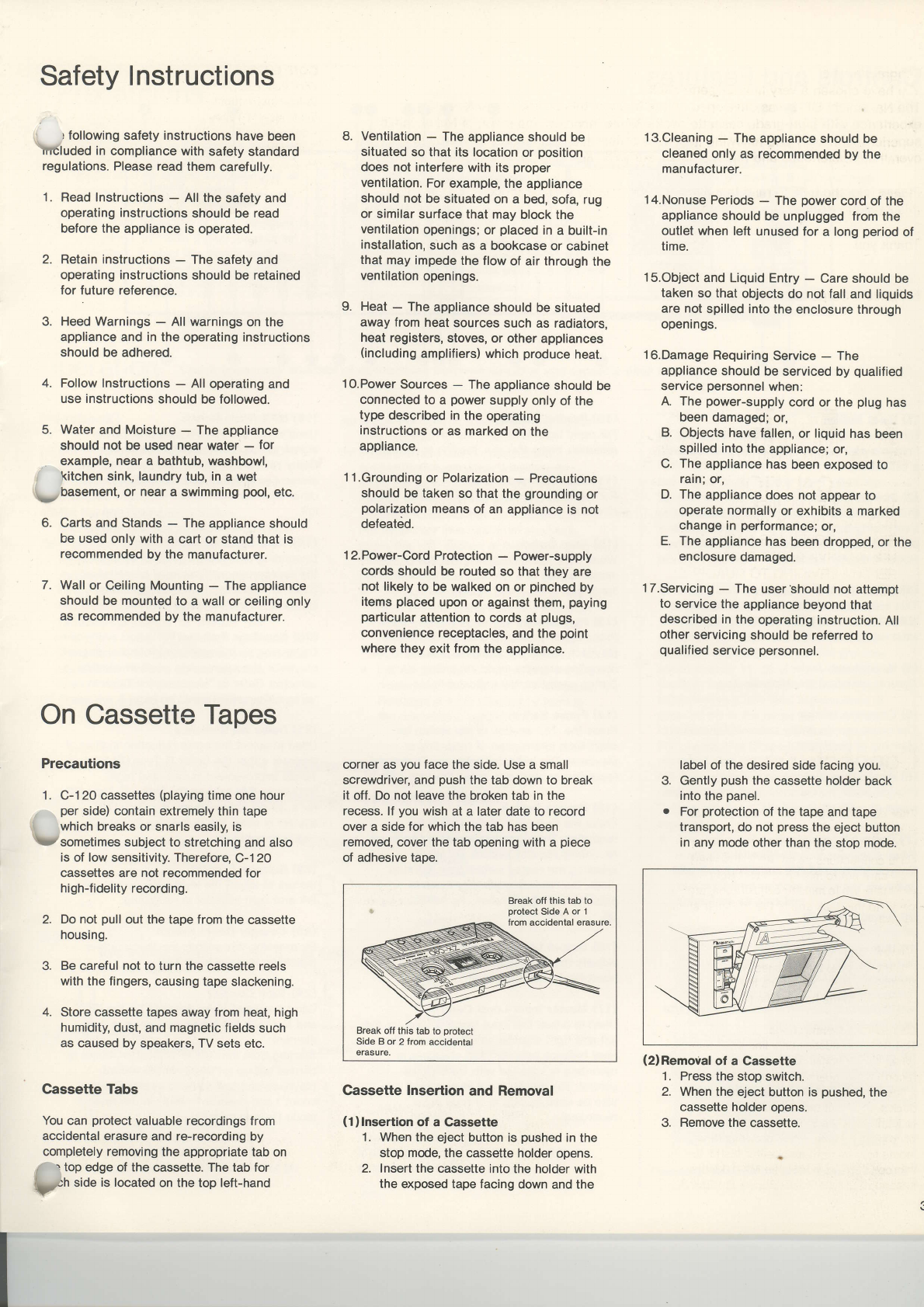
Safety
Instructions
r
following safety instructions
have
been
\r6luded in
compliance with
safety
standard
regulations.
Please read
them
carefully.
1. Read Instructions
-
All the
safety and
operating instructions
should
be
read
before
the appliance is
operated.
2.
Retain
instructions
-
The
safety and
operating instructions
should be retained
lor
future reference.
3. Heed Warnings
-
All warnings
on
the
appliance
and in the operating instructions
should be adhered.
4.
Follow lnstructions
-
All operating
and
use instructions
should
be followed.
5.
Water
and Moisture
-
The
appliance
should
not
be used
near
water
-
for
.
example, near a bathtub, washbowl,
,
kitchen
sink,
laundry
tub, in
a
wet
arbasement,
or near a swimming
pool,
etc.
6. Carts and
Stands
-
The
appliance should
be used
only with a
cart or stand that is
recommended
by the manufacturer.
7.
Wall or
Ceiling Mounting
-
The appliance
should be mounted
to a wall
or ceiling only
as recommended
by the manufacturer.
On
Cassette
Tapes
Precautions
1. C-120 cassettes
(playing
time one
hour
per
side) contain extremely thin tape
1,
which breaks
or snarls easily, is
Vsometimes
subject to
stretching and also
is of low sensitivity.
Therefore,
C-120
cassettes are
not
recommended
for
high{idelity recording.
2. Do not
pull
out the tape from
the cassette
housing.
3. Be careful not to turn the
cassette reels
with the fingers, causing
tape slackening.
4. Store cassette tapes away
from heat, high
humidity,
dust, and magnetic fields
such
as caused by
speakers, TV sets etc.
Cassette Tabs
You can
protect
valuable
recordings from
accidental erasure
and re-recording
by
completely removing
the appropriate tab
on
/
r
top edge of the cassette.
The tab for
pn
.io" is located
on the top left-hand
8. Ventilation
-
The
appliance
should be
situated
so that its location
or
position
does not interfere
with its
proper
ventilation.
For
example, the
appliance
should
not
be situated
on a bed,
sofa, rug
or similar
surface that may
block the
ventilation
openings;
or
placed
in
a built-in
installation,
such as
a bookcase
or cabinet
that
may impede
the flow
of
air through
the
ventilation
openings.
9. Heat
-
The
appliance
should be
situated
away from
heat
sources
such as radiators,
heat registers,
stoves, or
other appliances
(including
amplifiers)
which
produce
heat.
1O.Power
Sources
-
The
appliance
should
be
connected
to
a
power
supply
only of
the
type
described in the
operating
instructions
or as marked
on
the
appliance.
1 l.Grounding
or Polarization
-
Precautions
should be taken
so that
the
grounding
or
polarization
means
of an
appliance is not
defeatdd.
1 2.Power-Cord
Protection
-
Power-supply
cords
should be routed
so that they are
not likely
to be walked
on or
pinched
by
items
placed
upon or against
them,
paying
particular
attention
to cords at
plugs,
convenience receptacles,
and
the
point
where
they exit from
the appliance.
corner as
you
face the
side. Use
a
small
screwdriver, and
push
the tab down to break
it off.
Do
not leave
the broken tab in the
recess.
lf
you
wish
at a
later
date to record
over a side for which the tab has been
removed, cover the tab
opening with a
piece
of adhesive
tape.
Cassette Insertion
and
Removal
(1)lnsertion
of a Gassette
1. When
the eject button is
pushed
in the
stop
mode,
the cassette holder
opens.
2. Insert the cassette
into the holder
with
the exposed tape facing
down
and
the
l3.Cleaning
-
The
appliance
should be
cleaned
only as recommended
by the
manufacturer.
'1
4.Nonuse Periods
-
The
power
cord of the
appliance
should
be unplugged from
the
outlet when
left
unused for
a
long
period
of
time.
1S.Object
and Liquid
Entry
-
Care should be
taken
so that
objects
do not fall and liquids
are not
spilled into
the
enclosure through
openings.
16.Damage
Requiring
Service
-
The
appliance
should be
serviced by
qualified
service
personnel
when:
A. The
power-supply
cord or the
plug
has
been damaged;
or,
B. Objects
have fallen,
or
liquid
has been
spilled into
the
appliance;
or,
C. The
appliance
has
been exposed to
rain;
or,
D.
The appliance
does not
appear to
operate normally
or exhibits
a
marked
change in
performance;
or,
E.
The appliance
has
been dropped,
or the
enclosure
damaged
lT.Servicing
-
The
user'should
not
attempt
to
service
the appliance
beyond
that
described
in the
operating instruction.
All
other
servicing
should
be referred
to
qualified
service
personnel.
label
of the desired side facing
you.
Gently
push
the cassette
holder back
into
the
panel.
For
protection
of the tape and tape
transport, do not
press
the eject button
in any mode
other than the
stop
mode.
(2)Removal
of a Cassette
1.
Press the stop
switch.
2. When
the eject button is
pushed,
the
cassette holder opens.
3. Remove the
cassette.
L
Break off this
tab to
protect
Side
A or 1
trom accidental erasure
Break
off this
tab to
protect
Side B
or 2 from accidental
erasure.










